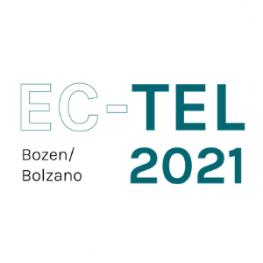Speakers
Ward Peeters
Kanda University of International Studies, JapanLeiden University, The Netherlands
Simon Buckingham Shum
Connected Intelligence Centre, University of Technology Sydney, AustraliaErika Godde
Université Grenoble Alpes, FranceStart
24/09/2021 - 09:00
End
24/09/2021 - 10:30
Address
Zoom Room 2 @ EC-TEL Gather Town View mapPaper Session 8: Invited Best Papers
Chair:  Angela Fessl
Angela Fessl
Best Paper ICCE’20: Applying Learning Analytics to Map Students’ Self-Regulated Learning Tactics in an Academic Writing Course
Ward Peeters[1,2], Mohammed Saqr[3] and Olga Viberg[4] [1] Kanda University of International Studies, Japan [2] University of Antwerp, Belgium [3] University of Eastern Finland, Finland [4] KTH Royal Institute of Technology, Sweden
Abstract: Academic writing is a complex and challenging language learning activity, in which self-regulation is a key critical factor for learner success. Today, a large number of academic writing activities occur in digital learning spaces, including computer-supported collaborative learning settings. Recent advances in the fields of learning analytics (LA) and computer-assisted language learning have provided new opportunities, in part because of the accessibility to new digital learner data, to better understand and ultimately support students’ self-regulated learning (SRL) processes. Even though some related efforts have been made, there is yet a paucity of research targeting foreign language students’ interactive SRL behaviour in online environments. This study aims to shed more light on this issue, and on the possible ways to fill this gap. We used LA methods (frequency analysis, network analysis, statistical analysis and process mining) to analyse and visualise students’ SRL tactics when collaborating with their peers on academic writing tasks on social networking sites. The dataset was obtained from a case study performed at the University of Antwerp (Belgium). In this study, a private Facebook group was integrated in an academic writing course for first-year foreign language majors of English (n=124) and served as an online collaborative space for peer review. The
results show, firstly, that foreign language learners use a range of SRL tactics to manage their academic writing process and, secondly, that the strategic SRL task phases (i.e., plan, perform and evaluate) are strongly interconnected. Learners exhibit a readiness and willingness to activate knowledge, monitor progress, interact to adjust to the socio-cultural context and form an identity as a learner. There is a significant positive correlation between students’ use of SRL tactics and their learning performance, which provides novel ground for designing and providing relevant SRL support mechanisms in computer-supported collaborative learning.
📄 Read More: https://apsce.net/icce/icce2020/proceedings/paper_143.pdf
Best paper AIED: Moodoo: Indoor Positioning Analytics for Characterising Classroom Teaching
Roberto Martinez-Maldonado[1], Vanessa Echeverria[2,3], Jurgen Schulte[4], Antonette Shibani[4], Katerina Mangaroska[1,5] and Simon Buckingham Shum[4] [1] Monash University, Australia [2] Escuela Superior Politécnica del Litoral, ESPOL, Ecuador [3] Human-Computer Interaction Institute, Carnegie Mellon University, USA [4] University of Technology Sydney, Australia [5] Norwegian University of Science and Technology, NTNU, Norway
Abstract: This paper presents Moodoo, a system that models how teachers make use of classroom spaces by automatically analysing indoor positioning traces. We illustrate the potential of the system through an authentic study aimed at enabling the characterisation of teachers’ instructional behaviours in the classroom. Data were analysed from seven teachers delivering three distinct types of classes to +190 students in the context of physics education. Results show exemplars of how teaching positioning traces reflect the characteristics of the learning designs and can enable the differentiation of teaching strategies related to the use of classroom space. The contribution of the paper is a set of conceptual mappings from x − y positional data to meaningful constructs, grounded in the theory of Spatial Pedagogy, and its implementation as a composable library of open source algorithms. These are to our knowledge the first automated spatial metrics to map from low-level teacher’s positioning data to higher-order spatial constructs.
📄 Read More: https://link.springer.com/chapter/10.1007/978-3-030-52237-7_29
Best paper EIAH: Longitudinal monitoring of reading fluency by automatic assessment
Erika Godde[1,2], Gérard Bailly[1], Marie-Line Bosse[2] [1] Grenoble INP, GIPSA-Lab, Université Grenoble Alpes, CNRS, France [2] LPNC, Université Grenoble Alpes, CNRS, France
Abstract: Reading fluency is usually assessed with the number of words correctly read in a minute. Expressivity and phrasing are then omitted, probably because these dimensions are more subjective and complex to assess. We propose here a new tool to assess the four dimensions of reading fluency : pace, smoothness, phrasing and expressivity. This tool use an automatic analysis of acoustic features and multiple expert references to predict the acore to a subjective scale. We show that this tool is valid, precise and more consistent than human raters. This tool is then well adapted to multiple assessments. We used it to assess the reading fluency of 49 young readers three times in CE1, CE2 and CM1 (grade 2, 3 and 4). These analyses enable us to characterize the development patterns of the four dimensions of reading fluency.



